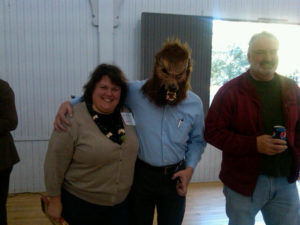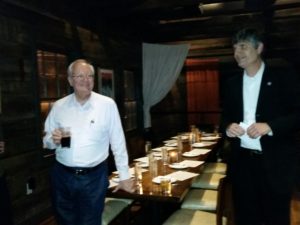
Chad Berginnis shares a story during the roast. To his right is Nicole LeBouef, new Deputy Assistant Administrator for NOAA for the National Ocean Service. Photo by Susan Fox.
Warmth is a concept with many dimensions. In the realm of physics, it is a relative measure of temperature. In reference to weather, perhaps the most common subject of human conversation, it is a measure of the kinetic energy of the atmosphere around us, which is constantly changing. Mark Twain has been erroneously quoted as saying, “Everybody talks about the weather, but nobody does anything about it.” His friend Charles Dudley Warner sort of said it, but no mind. On Tuesday, February 7, in Charleston, South Carolina, no one around me had any complaints. We were perfectly happy with the kinetic energy of the atmosphere of the day, which brought the city to a very comfortable 75° F. No rain, just a mild breeze. Let it be. (You can accurately take that quote from the Beatles.) Two days later, I would have to return to Chicago, where it was 18° F. when I stepped off the airplane.
Like many other English words, warmth takes on many metaphorical and emotional connotations derived from its physical qualities. “If you can’t stand the heat, get out of the kitchen,” President Harry Truman used to say, and he was not referring to room temperature in the White House. Conversely, there is the warmth of positive human relationships, just as there is a chill in the air when they are not going well.
That evening, at a downtown Charleston restaurant, Burwell’s, I experienced that warmth at a group dinner organized by some National Oceanic and Atmospheric Administration (NOAA) staff for those members of the NOAA Digital Coast Partnership who were attending the Coastal GeoTools Conference. The partnership consists of both NOAA, through its National Ocean Service, and eight national nonprofit organizations, including the American Planning Association, which I represented along with a colleague, Joseph DeAngelis, a research associate for the Hazards Planning Center. The conference was hosted for NOAA by the Association of State Floodplain Managers (ASFPM).

Susan Fox, NOAA point of contact for APA in the Digital Coast Partnership, presents a gift before the roast. Photo by Miki Schmidt.
But enough of the organizational details. Shortly after all our carloads arrived at Burwell’s, and our party of 24 was led upstairs by the wait staff, it became apparent that something special was afoot. Miki Schmidt, Division Chief for Coastal Geospatial Services at NOAA, attempted to get people’s attention by clinking empty glasses. It wasn’t working, so I decided to use my booming voice to say, “Miki wants your attention.” That worked. Then he announced, to my surprise, that they wanted to honor my upcoming retirement with a few gifts, among which were a framed certificate of appreciation from the U.S. Department of Commerce for my service in supporting Digital Coast and a framed photograph of those who had attended the last full meeting of the partnership in Rhode Island in September 2016, signed by many of the attendees. The warmth of the professional and personal relationships built with colleagues since APA joined the partnership in 2010 became readily apparent to me in this unexpected moment.
Then we sat down, and the “roast” began. More than once, as Miki seemed ready to turn the floor over to me for the final word, someone new would pop up to offer stories both fun and serious. Yes, it was true that I had once, wearing a moveable wolf mask, climbed through the open window of a park shelter in Madison, Wisconsin, during an evening reception for a partnership meeting hosted by ASFPM, asking the whereabouts of “them three little pigs.” Undaunted by the momentary confusion my entrance engendered, Allison Hardin, a planner from Myrtle Beach, South Carolina, insisted on posing for a photograph with the wolf, who politely obliged. I was known (though not alone) in trying to provide such moments to enliven the more relaxing moments of partnership gatherings. When my “final word” finally came, I shared not only some enhancements of the recollected moments, but my own plans beyond APA, which I discussed in a recent blog post, “The Fine Art of Stepping Down.”
Still, the Digital Coast Partnership was also built through a great deal of hard work, which was also celebrated. The representatives of the groups involved worked hard over the past decade to build the partnership, which is now celebrating its tenth year. Meetings sometimes involved long discussions of how we could better collaborate, and we now often partner on important proposals and projects in which our complementary strengths facilitate important progress in achieving Digital Coast’s mission. NOAA established Digital Coast to advance the use of geospatial technology by coastal communities to improve and enhance coastal planning and resource management. Much of this consists of a substantial and growing of free, online tools and resources for mapping and visualization purposes. The partnership consists of the user communities that can help vet Digital Coast products and assist in their dissemination. But the operative Digital Coast slogan has been “More than just data.” It is the human dimension that matters, and the science and technology have been means to an end, which is enabling the achievement of noble coastal community goals such as environmental protection, hazard mitigation, economic sustainability, and climate resilience.
And so—I suppose it was appropriate that the organizers of the dinner chose to bring us to Burwell’s Stonefire Grill, which generates its own warmth through its comfort menu of steaks and seafood. Though it certainly can be pricey like any steakhouse (most steak entrees are between $30 and $40), the food is outstanding. Personally, I indulged in the lobster bisque for starters. It offered some of the deepest, most flavorful spoonfuls of joy of any bisque I have had in a long time. Alan, our waiter, was not lying at all when he told me it was great. On the subject of warmth, let me add that the wait staff of Alan, Mat, and Will were very patient and careful in tending to this large crowd, as was bartender Jo Jo Chandler. I did not meet the owner, John Thomas, but he is to be commended for both the staff and the cuisine. The Wagyu flat iron steak that I ordered was tender and delicious. I also indulged in a side order of Brussels sprouts, which I love but which require some attentive preparation to succeed. These were great in part because they were prepared in combination with caramelized onions. Others around me
enjoyed the seafood offerings, including oysters and scallops, and I heard no complaints and considerable praise. I can assure readers that, if you visit Charleston, Burwell’s is worth a visit for one of your evening outings. It also features a warm and casual atmosphere and a good downstairs bar, from which that amber beer in my hand originated, courtesy of Chad Berginnis, the executive director of ASFPM. I wasn’t sure, when we first arrived, why he offered to buy. Now I suspect he was in on the “roast” plan all along. Thanks, I say, to all of my friends at Digital Coast. My actual retirement from APA may have been almost four months away, but they knew this might be the last chance to do it before that day came. I hope they do the same for others when the time comes.
Jim Schwab

